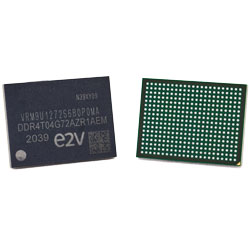
Teledyne E2V Semiconductors' ultra-high density DDR4 memory is currently being shipped to major customers worldwide.
The Teledyne E2V's DDR4 storage capacity is 4 Gbytes and measures just 15 mm x 20 mm x 1.92 mm, making it far more dense than competing solutions -- it takes up half the space of a PCB and is nearly an order of magnitude smaller. They continue to perform well, delivering data transfer speeds of 2.4GT/s.
Each DDR4T04G72 memory is provided in a multi-chip package with extended bus capabilities, with 64 bits for data transmission and 8 bits for error correction. The memory is a perfect companion to the company's Qormino processors, which are also compatible with most processors, soCs and FPGas from other vendors.
Due to its high reliability structure and high radiation tolerance, these devices will become key resources for edge computing platforms for space deployment. Radiation tests and characterization of these DDR4 showed that their SEL threshold was greater than 60 mev.cm ²/mg. Their SEU and SEFI data also exceeded 60MeV. Cm ²/mg, and they've shown that 100krad TID is elastic.
DDR4 can be ordered in the industrial temperature range (-40C to 105C) and defense temperature range (-55C to 125C) as well as up to NASA Class 1 (based on NASA EEE-INST-002-Section M4-PEM). This means a wider range of potential applications can be addressed.
Thomas Guillemain, marketing and business development manager for Teledyne E2V said:."We are recognized as a leader in enhanced density radiation-resistant memory for space applications, and our technology has received incredible reviews in the marketplace. What sets us apart from our competitors is that we offer comprehensive and open packages that give our customers everything they need to start a design and complete it in the shortest possible time, with all the background information and expert engineering support readily available." "The aerospace industry has raised the performance benchmark by providing a compact, easy-to-interface memory. We are making great progress in the next phase of our roadmap, with other generations of larger capacity devices currently in development."